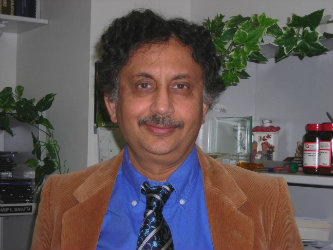Engineer honored for clean water efforts
Arup SenGupta has spent three decades inventing systems that clean toxins from contaminated drinking water, teaching people to use those systems and giving them an economic incentive to do so.
The technologies that he and his students have developed are credited with providing more than 1 million people with clean water while reducing rates of dysentery, cholera, hepatitis and infant mortality.
SenGupta has won numerous awards for his work, and this week he added another honor when he was elected a Fellow of the National Academy of Inventors (NAI).
SenGupta, the P.C. Rossin Professor of civil and environmental engineering and also of chemical engineering, will be inducted on March 20 along with 169 other new NAI Fellows at the organization’s Fourth Annual Conference at the California Institute of Technology.
NAI, an international organization of universities and governmental and nonprofit research institutions, has more than 3,000 individual inventors in its membership. It was founded in 2010 to recognize and encourage inventors and to promote technology transfer.
According to the organization’s website, election as NAI Fellow is accorded “to academic inventors who have demonstrated a highly prolific spirit of innovation in creating or facilitating outstanding inventions that have made a tangible impact on quality of life, economic development and the welfare of society.”
From crisis to opportunity
SenGupta and his students invented the world’s first reusable arsenic-selective adsorbent to remove that toxin from groundwater. More recently, they have developed an adsorbent that removes both arsenic and fluoride from groundwater
Millions of people in all parts of the world drink groundwater that contains arsenic, fluoride or other naturally occurring contaminants. Arsenic contamination is especially acute in India and Bangladesh, where an estimated 100 million people are affected, and in Southeast Asia and Africa, but it is also prevalent in the United States and other industrialized nations.
SenGupta’s technologies are being used by communities in Asia, Europe, Africa, and North and South America. Residents of many of these communities learn to maintain their systems and pay a small monthly fee to use them.
In 2012, SenGupta was one of six entrepreneurs to win the Intel Environmental Award from TechAwards, a nonprofit founded by multinational corporations in Silicon Valley. He was recognized for using technology to transform a water crisis into an economic enterprise.
SenGupta donated his prize money to the Tagore-SenGupta Foundation (T-S), an organization he started with his students, which supports community projects related to clean water, sanitation and education.
In 2011, T-S won the 2011 Reed Elsevier Environmental Challenge, an international contest that aims to improve people’s access to safe and sustainable water. Reed Elsevier cited T-S for its efforts to install its arsenic-removal system in Cambodian villages and schools.
In 2009, SenGupta received the Lawrence K. Cecil Award from the American Institute of Chemical Engineers, for outstanding contributions to environmental engineering, and the Astellas Foundation Award from the American Chemical Society for scientific research that improves public health. His research was cited by the Better World Report 2009 as one of 22 “Innovations from Academic Research That Positively Impact Global Health.”
In 2008, the American Society of Civil Engineers named SenGupta’s project “Arsenic Crisis in the Indian Subcontinent: A Sustainable Engineering Solution” as one of five Outstanding Civil Engineering Achievement projects.
Also in 2008, the Institution of Chemical Engineers in the United Kingdom gave SenGupta the Dhirubhai Ambani Award for developing “Engineering Innovations to Provide Potable Water to Resource-Poor Arsenic-Affected People.”
In 2007, SenGupta received the Grainger Silver Prize Award from the National Academy of Engineering for “providing a sustainable engineering solution for arsenic-contaminated drinking water in the Indian subcontinent.”
And in 2005, he received the Mondialogo Engineering Award from Daimler-Chrysler and UNESCO for installing his arsenic-removal project in the villages of the Indian state of West Bengal.
* * *
The NAI’s 414 Fellows include 61 presidents and leaders of research institutes; 208 members of the National Academy of Science, the National Academy of Engineering and the Institute of Medicine; 21 members of the National Inventors Hall of Fame; 16 recipients of the U.S. National Medal of Technology and Innovation; 10 recipients of the U.S. National Medal of Science; 21 Nobel Laureates; 11 Lemelson-MIT prize recipients; 112 Fellows of the American Association for the Advancement of Science, and 62 Fellows of the Institute of Electrical and Electronic Engineers.
Story by Kurt Pfitzer
Posted on:


